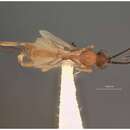Distribution
provided by Catalog of Hymenoptera in America North of Mexico
Conn., D. C., Fla.
- bibliographic citation
- Catalog of Hymenoptera in America North of Mexico. 1979. Prepared cooperatively by specialists on the various groups of Hymenoptera under the direction of Karl V. Krombein and Paul D. Hurd, Jr., Smithsonian Institution, and David R. Smith and B. D. Burks, Systematic Entomology Laboratory, Insect Identification and Beneficial Insect Introduction Institute. Science and Education Administration, United States Department of Agriculture.
Comprehensive Description
provided by Smithsonian Contributions to Zoology
Orgilus disparilis
From immarginatus, new species, which this species resembles in its unusually large eyes and in the fine granulose sculpture of the vertex and temples, it is immediately distinguished by having the occiput carinately margined at the sides and by its coriaceous meso- and metapleura.
FEMALE.—Length about 4 mm. Head a little wider than thorax, wider than high in front view, twice as wide as long in dorsal view, and nearly flat behind; face very finely punctate, its width less than eye height; clypeus not separated from face medially; anterior tentorial pits just above level of lower eye margins; malar space only half as long as longest segment of maxillary palpus and hardly one-sixth the eye height; temples very narrow, strongly receding and, together with cheeks and vertex, finely granulose and mat; occipital carina weak and incomplete but distinct at the sides, ocellocular line barely longer than diameter of an ocellus; antennae of holotype incomplete, those of a female paratype 38-segmented, conspicuously thinner apically, all flagellar segments longer than broad, the terminal segment provided with a short stout apical spicule.
Mesoscutum without a sculptured area at junction of notauli, which are weakly foveolate or punctate; scutellum flat; propodeum virtually horizontal, only slightly declivous at apex, finely granulose and mat; side of pronotum minutely granulose, very weakly so above the impression; mesopleuron and metapleuron coriaceous, the former weakly so and shining, the latter rather dull; the longitudinal furrow of mesopleuron straight, not distintly foveolate. Hind coxa at least 0.75 as long as hind femur, finely shagreened; hind femur somewhat compressed and only about three times as long as broad; inner spur of hind tibia much more than half as long at metatarsus; tarsal claw without a subbasal tooth. Stigma only 0.75 as long as radial cell on wing margin; stub of third abscissa of cubitus not more than one-third as long as second abscissa; nervulus postfurcal by nearly half its length; hind wing about 4.3 times as long as wide; lower abscissa of basella shorter than or subequal to nervellus and much less than half as long as mediella.
Abdomen hardly as long as thorax; first tergite only a little longer than broad at apex, delicately coriaceous; second tergite twice as broad as long and, together with the third, sculptured like the first although even more weakly; suture between second and third tergites distinct; fourth and following tergites smooth; ovipositor sheath about as long as abdomen, conspicuously hairy.
Ferruginous; palpi yellow; stemmaticum black; legs concolorous with the body except that the hind tibia is pale yellow at extreme base and has a dark subbasal annulus, and the hind tarsus is somewhat darkened; tegulae and wing bases testaceous to ferruginous; wings clear hyaline; apical abdominal tergites more or less darkened.
MALE.—Like the female in essential particulars; antennae 37-segmented.
HOLOTYPE.—USNM 70158.
DISTRIBUTION.—Known only from the type-series comprised of the following: Holotype female, Gainesville, Florida, 13 May 1962, F. W. Mead; paratype male, Levy County, Florida, 6 May 1955, F. W. Mead; paratype female, Washington, D.C., 24 June 1915, V. A. Roberts, and a second paratype female, Lyme, Connecticut, 25 July 1918, W. S. Fisher.
- bibliographic citation
- Muesebeck, Carl F. W. 1970. "The Nearctic species of Orgilus Haliday (Hymenoptera: Braconidae)." Smithsonian Contributions to Zoology. 1-104. https://doi.org/10.5479/si.00810282.30

